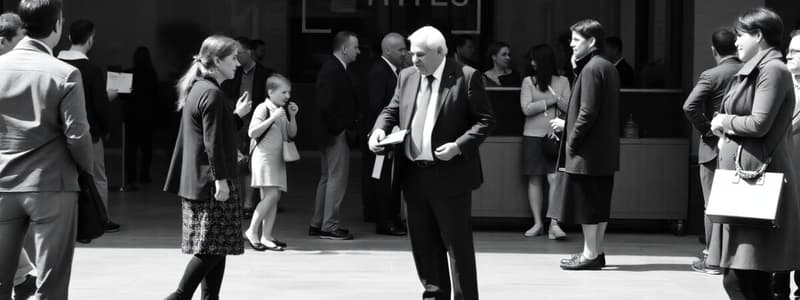Podcast
Questions and Answers
What does Goffman suggest is the basis of social life?
What does Goffman suggest is the basis of social life?
- Spontaneous interactions between individuals
- Fixed social structures that govern behavior
- Pre-determined roles based on social status
- Ritualized performances based on dramaturgical practices (correct)
In the dramaturgical perspective, how is social life represented?
In the dramaturgical perspective, how is social life represented?
- As a series of competing individual interests
- As a fluid exchange of ideas among peers
- As a chaotic mix of personal motivations
- As actors playing roles on a stage (correct)
Which concept did Goffman emphasize in his view of social interactions?
Which concept did Goffman emphasize in his view of social interactions?
- Emotional intelligence
- Cultural hegemony
- Resilience in social structures
- Interaction order (correct)
What characterizes the performances in social life according to Goffman?
What characterizes the performances in social life according to Goffman?
What is a key metaphor in Goffman's dramaturgical perspective?
What is a key metaphor in Goffman's dramaturgical perspective?
What is the basic assumption of the dramaturgical approach?
What is the basic assumption of the dramaturgical approach?
Which principle is considered foremost in the dramaturgical approach?
Which principle is considered foremost in the dramaturgical approach?
In the context of the dramaturgical approach, how might individuals manage impressions?
In the context of the dramaturgical approach, how might individuals manage impressions?
What does the term 'performance' refer to in the dramaturgical approach?
What does the term 'performance' refer to in the dramaturgical approach?
Which of the following statements aligns with the fundamental belief of the dramaturgical approach?
Which of the following statements aligns with the fundamental belief of the dramaturgical approach?
What is a key characteristic of front stage encounters?
What is a key characteristic of front stage encounters?
In front stage situations, individuals primarily engage in which of the following behaviors?
In front stage situations, individuals primarily engage in which of the following behaviors?
Which of the following best describes the purpose of front stage behavior?
Which of the following best describes the purpose of front stage behavior?
What type of roles are typically acted out during front stage encounters?
What type of roles are typically acted out during front stage encounters?
Impression management is a primary focus in which of the following contexts?
Impression management is a primary focus in which of the following contexts?
What is the primary function of the front in a performance?
What is the primary function of the front in a performance?
In what manner does the front of a performance function?
In what manner does the front of a performance function?
Why is the front important for observers in a performance?
Why is the front important for observers in a performance?
Which of the following is NOT a characteristic of the front in a performance?
Which of the following is NOT a characteristic of the front in a performance?
The front can be described as functioning primarily to:
The front can be described as functioning primarily to:
What does Goffman emphasize as essential for understanding stigma?
What does Goffman emphasize as essential for understanding stigma?
According to Goffman, stigma is not simply an attribute but rather is defined by what?
According to Goffman, stigma is not simply an attribute but rather is defined by what?
Which statement accurately reflects Goffman's view on stigma?
Which statement accurately reflects Goffman's view on stigma?
What is the primary focus of Goffman’s conception of stigma?
What is the primary focus of Goffman’s conception of stigma?
How should stigma be viewed based on Goffman’s perspective?
How should stigma be viewed based on Goffman’s perspective?
What does the personal front primarily consist of?
What does the personal front primarily consist of?
Which of the following components is part of the personnel front?
Which of the following components is part of the personnel front?
How might an audience expect performers to present their personal front?
How might an audience expect performers to present their personal front?
What is NOT included in the concept of personal front?
What is NOT included in the concept of personal front?
Which aspect is specifically mentioned as part of the personnel front?
Which aspect is specifically mentioned as part of the personnel front?
Flashcards
Impression Management
Impression Management
The idea that people try to control how others perceive them.
Performance (Dramaturgical Approach)
Performance (Dramaturgical Approach)
An individual's actions and behaviors aimed at shaping how others view them.
Front (Dramaturgical Approach)
Front (Dramaturgical Approach)
The setting, props, and behaviors used to create the desired impression.
Backstage (Dramaturgical Approach)
Backstage (Dramaturgical Approach)
Signup and view all the flashcards
Others (Dramaturgical Approach)
Others (Dramaturgical Approach)
Signup and view all the flashcards
Interaction Order
Interaction Order
Signup and view all the flashcards
Dramaturgical Practices
Dramaturgical Practices
Signup and view all the flashcards
Dramaturgical Perspective
Dramaturgical Perspective
Signup and view all the flashcards
Front Stage
Front Stage
Signup and view all the flashcards
Formal Roles
Formal Roles
Signup and view all the flashcards
Positive Impression
Positive Impression
Signup and view all the flashcards
Social Interaction
Social Interaction
Signup and view all the flashcards
Front of a performance
Front of a performance
Signup and view all the flashcards
Elements in the front
Elements in the front
Signup and view all the flashcards
Fixed and predictable front
Fixed and predictable front
Signup and view all the flashcards
Purpose of the front
Purpose of the front
Signup and view all the flashcards
Framework of the performance
Framework of the performance
Signup and view all the flashcards
Personal Front
Personal Front
Signup and view all the flashcards
Personnel Front
Personnel Front
Signup and view all the flashcards
Appearance
Appearance
Signup and view all the flashcards
Manner
Manner
Signup and view all the flashcards
Personal and Personnel Front: Together
Personal and Personnel Front: Together
Signup and view all the flashcards
Stigma as a Social Construct
Stigma as a Social Construct
Signup and view all the flashcards
Stigmatized Attributes
Stigmatized Attributes
Signup and view all the flashcards
Social Relation and Stigma
Social Relation and Stigma
Signup and view all the flashcards
Stigmatizing Interactions
Stigmatizing Interactions
Signup and view all the flashcards
Understanding Social Context and Stigma
Understanding Social Context and Stigma
Signup and view all the flashcards
Study Notes
Symbolic Interactionism
-
Symbolic interactionism is a theoretical perspective that focuses on the interactions between individuals and how those interactions shape society.
-
Social interaction is any form of encounter between individuals, including formal and informal situations. Examples include classroom interactions and conversations in public spaces.
Goffman: Presentation of the Self
-
Goffman's work, "Presentation of Self in Everyday Life" (1959), explores the tension between the spontaneous self ("I") and social constraints on the self ("Me").
-
Goffman viewed social life as a series of performances, where individuals present a particular image to others. This is akin to actors on a stage trying to maintain a specific persona.
-
The dramaturgical perspective views social life as analogous to actors on a stage, with performance and impression management playing key roles. Goffman argued much human behavior is about managing the impressions others have of you.
Interaction and Performance
-
Interaction is the reciprocal influence people have on each other's actions when they are physically present.
-
Performance refers to all activity engaged in by an individual in front of an audience, influencing the observers. This includes things like dress, demeanor, and conversation.
Impression Management
-
Impression management describes the strategies people use to convey a favorable image to others.
-
Example strategies include dressing in a specific way, acting in a certain manner, and controlling one's language.
Front and Back Stages
-
Front stage refers to situations where people are trying to maintain a specific image for an audience. This includes situations where one is actively engaged in impression management.
-
Back stage is where individuals relax from the performance of the front stage. This is where one can be themselves without the concern of maintaining a formal role.
Components of Performance
-
Front: The fixed and general ways a performance is structured to define the situation.
-
Setting: The physical environment required for the performance to occur- the stage.
-
Personal front: Items like appearance, demeanor, and behavior which are associated with and help define the social role the individual is performing. The way an individual dresses, talks, and walks are all part of their personal front.
Role and Status
-
Role: The expectations associated with a specific social position (status).
-
Social status: A socially recognized position within a social system. This is a socially defined position.
Types of Social Status
-
Ascribed status: A status assigned to an individual without regard to their actions; often happens by birth— like race or family background.
-
Achieved status: A status earned through an individual's actions (e.g., a college degree or a career advancement).
-
Master status: A dominant status that overshadows other statuses and is very important for both the person holding the status and others.
Stigma
-
Stigma represents attributes that deeply discredit individuals, reducing them from normal to tainted. Societal definitions of normalcy and behavior define stigma.
-
Stigma operations through relationships, not just individual attributes. The way others perceive and interact with the stigmatized person plays a role.
-
Not all are stigmatized; those who follow societal norms and expectations are not stigmatized.
Studying That Suits You
Use AI to generate personalized quizzes and flashcards to suit your learning preferences.




